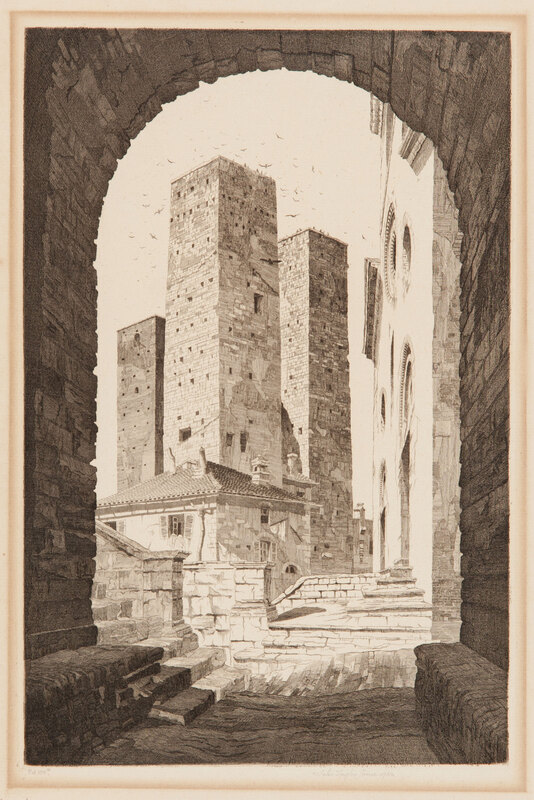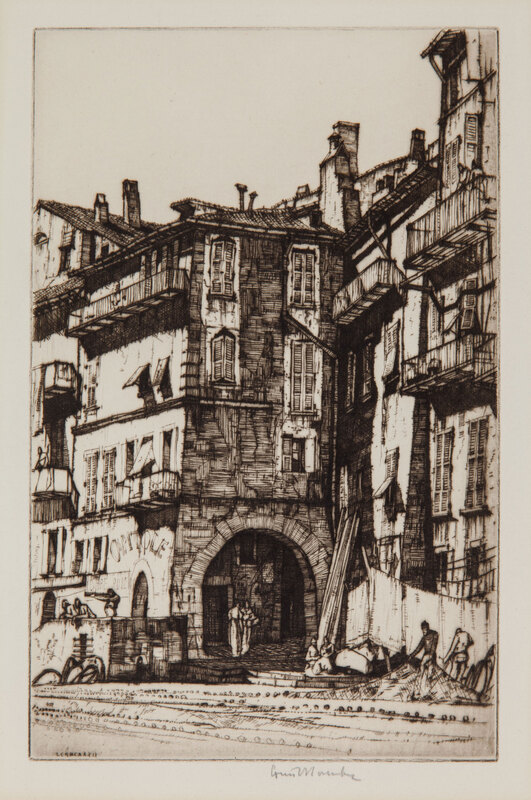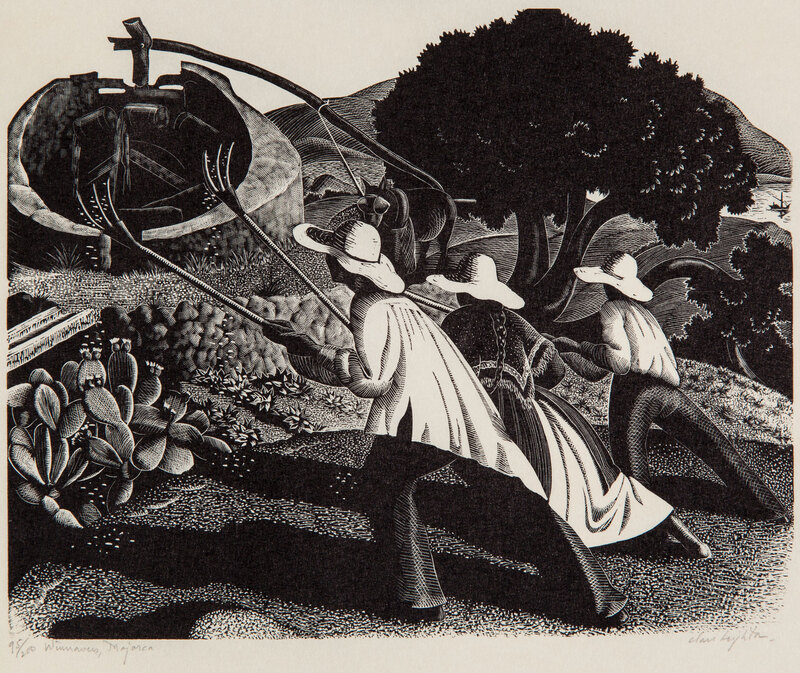Americans Abroad
Americans, including artists and social elites, flocked to Europe in the early twentieth century to take in the museums and historic sites. Artists produced inexpensive prints of European ruins, architectural marvels and more, contrasting with images of America, which emphasized the new and bold.
In the early decades of the twentieth century, many among the country’s social elite still considered the United States a cultural backwater—a fledgling nation, without the deeply rooted traditions and great monuments of art that crowned the capitals of Europe. Those with the means and the leisure traveled overseas to imbibe the revered landscapes and renowned museums of France, Germany, Italy and elsewhere. This Americanized version of the “Grand Tour”—that English aristocratic custom of visiting the sites of classical European culture as the culmination of a proper education—conveyed a level of social status on those who undertook it, distinguished their taste and discrimination, and consolidated their position in the American class hierarchy.
Many American artists likewise traveled to Europe. Paris remained the West’s cultural capital, and every ambitious painter or sculptor dreamed of partaking directly the artistic riches it and other European cities had to offer. Those riches were to be found not only in the galleries of the Louvre or the Uffizi, however, but also along the streets and byways of cities and countryside, in the cathedrals and ancient landmarks that offered up innumerable “picturesque” vistas to the cultured eye. In perceived contrast to American cities—understood as the product of the country’s brash youthfulness, if not of its insatiable thirst for profits—those of Europe seemed to offer a species of timeworn beauty, whether in crumbling monuments or close-knit villages.
These architectural scenes carried multiple meanings. At the most basic level, pictures of European landmarks confirmed the sophistication of those whose walls they graced, reminding their American owners of sites visited on those rare opportunities for travel in an age before flight. These relatively inexpensive prints also offered access to a carefully proscribed, Western high culture for people who could not themselves afford to travel abroad, opening a window onto a wider world. In addition, following the wake of the First World War, and amidst the predominant isolationism of American politics, images of the centuries-old, moldering edifices of Europe might have reminded viewers—in implicit contrast to the views available out their own windows—of the strength and vitality of their own homeland. While such artworks continued to be made during the Great Depression, American artists increasingly turned away from European scenes to capture the distinct features of their own national landscape.
––TMD
Jane Peterson (American, 1876 – 1965)
Courtyard of the Doges’ Palace, Venice, 1919
oil on canvas; 32 x 32”
Roberson Museum and Science Center, 1972M4
gift of Thomas J. Watson
Most American artists who journeyed to work in Europe were men—in the early years of the twentieth century, middle-class propriety still forbade women from traveling so freely. Jane Peterson was an exception: she moved away from her Midwestern family to study painting in New York when she was just shy of nineteen years old; and at thirty, she made her first trip to Europe, to which she would return repeatedly over the following decades.
This painting, rendered in Peterson’s typically loose, impressionistic brushwork, takes us into the courtyard of the Doges’ Palace—the onetime residence of the elected leaders of the Venetian republic, dating back to the fourteenth century—where we look upon the famed Giants’ Staircase. The artist’s greatest interest is directed, however, less at the Renaissance architectural ornamentation than at the light and shadow that play across it, and at the crowd of tourists occupying the enclosure, including a group of three women prominently placed in the center foreground.
––TMD
John Taylor Arms (American, 1887 – 1953)
Saint-Germain l’Auxerrois, Paris, 1928
etching; 14 ¾ x 9”
Binghamton University Art Museum, 2016.4.29
gift of Gil and Deborah Williams
Interpretive text has not been prepared for this object.
John Taylor Arms (American, 1887 – 1953)
Towers of San Gimignano, from the “Italian Series (24),” 1932
etching; 14 ¾ x 9 ¾”
Binghamton University Art Museum, 2016.4.256
gift of Gil and Deborah Williams
Interpretive text has not been prepared for this object.
Morris Henry Hobbs (American, 1892 – 1967)
Notre Dame, Paris, 1930
drypoint; 11 ½ x 9”
Binghamton University Art Museum, 2016.4.14
gift of Gil and Deborah Williams
Even as Paris remade itself into a modern city over the second half of the nineteenth century, artists continued to be drawn to its most picturesque aspects, and especially to the charm of its remaining medieval neighborhoods. Here we find ourselves down along the Seine, in the historic heart of Paris, looking across the river at some of the few enduring ancient houses that line the quay of the Île de la Cité; we just glimpse the roofline of the cathedral of Notre-Dame de Paris rising behind them, its iconic steeple—actually a mid-nineteenth century addition, although mimicking the Gothic style of the original structure—piercing the skyline.
After service during the First World War, Morris Henry Hobbs became a practicing architect, but by the mid-1920s, his interest in art drew him back to Europe to study. This print, published by the Chicago Society of Etchers—a print club dedicated to popularizing the medium of etching—was inspired by a 1930 trip to England and France.
––TMD
Louis Conrad Rosenberg (American, 1890 – 1983)
Drying Nets, Villefranche, 1929
drypoint; 14 ¼ x 10”
Binghamton University Art Museum, 2016.4.381
gift of Gil and Deborah Williams
Interpretive text has not been prepared for this object.
George A. Bradshaw (American, 1880 – 1968)
Rue Sous le Cap, Quebec, ca. 1934
drypoint; 14 ¼ x 10 ¾”
Binghamton University Art Museum, 2016.4.85
gift of Gil and Deborah Williams
Interpretive text has not been prepared for this object.
Emil Ganso (American, born Germany, 1895 – 1941)
The Harbor, 1930
woodcut; 4 ¾ x 6”
Binghamton University Art Museum, 2016.4.27
gift of Gil and Deborah Williams
Set against a steeply rising, rocky landscape, a small waterfront village faces its harbor, where a two-masted brig sits at anchor just offshore. Emil Ganso, an accomplished printmaker, here adopts the woodcut technique to capture this Mediterranean scene; woodcut’s simplicity and expressivity must have appealed to him, and in Harbor it produces a decidedly modern effect. He balances the dynamism of rhyming diagonals—in the masts and rooftops—against the tranquility of an insistent horizontality in the still water and boat hull of the foreground, as well as in the line of the hillside behind.
Motivated by a European trip of 1929, Ganso made this print after his return home to the art colony in Woodstock, New York; it was exhibited at the influential Weyhe Gallery in New York City in Spring 1930.
––TMD
Clare Leighton (American, born England, 1898 – 1989)
Winnowers, Majorca, 1937, published 1939
wood engraving; 8 x 9 ½”
Binghamton University Art Museum, 2016.4.376
gift of Gil and Deborah Williams
Interpretive text has not been prepared for this object.







